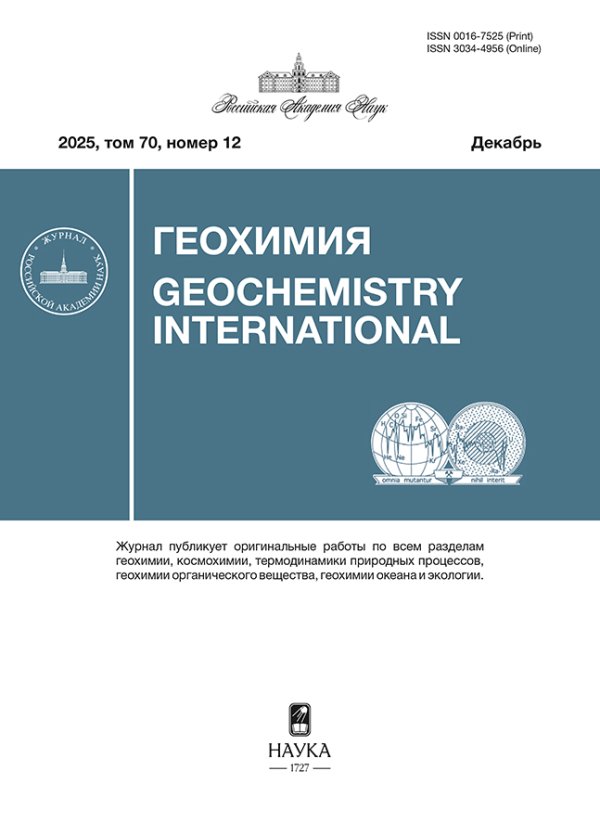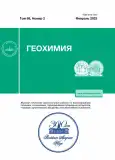Vol 68, No 2 (2023)
Articles
Nature of Hydrocarbon Fluids at the Fields in the North of Western Siberia: the Geochemical Aspect
Abstract
The paper presents original results of comprehensive geochemical studies of samples of oils, condensates, gases, core, and cuttings from wells drilled in the north of Western Siberia. The studies involved chromatographic and mass spectrometric determinations of the molecular and isotopic composition of the oils, gases, condensates, and rock extracts. Analysis of the results, considered together with literature data, made it possible to draw conclusions regarding the source of the hydrocarbons and the mechanism of formation of their accumulations. Information on the molecular and isotopic composition of the fluids and the distribution of their accumulations and fields in the sedimentary cover shows that most of them are of polychronic and polygenic origin. Features of the molecular and isotopic composition of the fluids make it possible to evaluate the contribution of various sources to the formation of hydrocarbon accumulations. The composition of their liquid component was formed as a result of the generation of hydrocarbons by the organic matter of Jurassic source rocks. The Lower and Middle Jurassic rocks with non-marine organic matter also made a significant contribution to the formation of the gas component of deposits in the north of Western Siberia, whereas the Cretaceous rocks generated only dry gas and were likely the main source of gas for the giant fields, whose methane has a light carbon isotope composition. The use of the isotopic composition of carbon in combination with molecular parameters makes it possible to clarify the conditions under which a particular field was formed and to elucidate the migration pathways and distances of hydrocarbon fluids to their accumulation sites
 115-138
115-138


Geochemistry of hydrocarbons-biomarkers and carbon isotopes of organic matter in the Domanik Deposits of the Timan-Pechora Basin
Abstract
It has been established that the average values of some hydrocarbons biomarker coefficients of bitumens from the Domanik deposits and oils from the Domanik–Tournaisian complex coincide. These are the proportions of C27–C29 steranes, tri-/pentacyclanes ratio, and coefficients 2 × С17/С16 + С18 and 2 × С27/С26 + С28 calculated from n-alkane composition. Such indicators as the Pr/Ph, (Pr + Ph)/(n‑C17 + n‑C18), dia-/reg-steranes, and the sterane/hopane ratios in oils are slightly lower than in the bitumen. The average values of δ13C in asphaltene, resin, aromatic hydrocarbons, and aliphatic hydrocarbons fractions from oils of the Domanik genotype and in the studied bitumens are similar. The carbon isotope composition of asphaltenes in oils is depleted in 13С compared to those of resins and aromatic hydrocarbons, and vice versa in bitumens. A heterogeneous composition of the bacterial flora in the sediments of the Domanik Sea is suggested. In some places, species with high concentrations of diplopterol or hexafunctional bacteriohopanes likely dominated over bacteriohopantetrol.
 139-148
139-148


Applicability Limits of the Maturity Concept in Organic Geochemistry
Abstract
To find out how various maturity criteria reflect how much OM as a whole approaches the state of chemical equilibrium, correlation analysis of relationships between 27 composition parameters was carried out. The OM was obtained from carbonate, siliceous–carbonate, carbonate–siliceous, and siliceous rocks from the northern and central regions of the Volga–Urals area (more than 100 samples). The data were processed using the apparatus of nonparametric statistics. We analyzed interrelations only between maturity indicators that are based on the same type of reactions (for example, reactions breaking C–C bonds). It has been established that none of the 85 correlation coefficients corresponds to the values characteristic of the functional dependence. The largest absolute value is 0.87. Therefore, maturity can be a factor determining the value only of one of all the parameters. For the rest, two options are possible. First, even for reactions of the same type, it is impossible to judge whether chemical equilibrium is generally approached. Second, the values of almost all the parameters are affected not only by reactions of approaching equilibrium but also by several other comparable and unknown factors. It is shown that, if the difference between the samples is up to five-fold values of any of the parameters, it is impossible to determine whether the OM of one of the samples is more mature than in any other. Thus, the concept of maturity is applicable at best only to roughly subdivide OM samples, with an increment in any parameter corresponding to at least a ten-fold change in it. For a detailed description, the term maturity can be used only with specifying the parameter by which it is determined (for example, maturity based on the Ts/Tm ratio). In this case, several such indicators based on reactions of different type should be used.
 149-162
149-162


Peculiarities of CH4 and CO2 Distribution in Sediments of the Arctic Seas
Abstract
The distribution of the concentrations of CH4 and CO2 and other gases in the sediments of the Kara, Laptev and East Siberian seas was studied. A correlation was found between CH4 and CO2 in most sediment cores. The correlation coefficient R for the sediments of the Kara Sea ranges from 0.58 to 0.97 and does not depend on the gas distribution with depth. Methanogenesis in marine sediments is presumably associated with sulfate reduction, and hydrogenotrophic methanogenesis leads to an increase in CH4 concentration against the background of high CO2 concentration. The high concentration of dimethyl sulfide in the sediments indicates the simultaneous formation of CH4 and CO2 through methylotrophic methanogenesis with the participation of CH3SCH3. In the upper layers of the sediment, opposite trends in the CH4 and CO2 distribution can be observed. The fact that the correlation coefficients between CH4 and CO2 gases in the sediments of the Laptev Sea acquire both negative and positive values is probably related to the fact that gas formation processes in the upper layers of the sediment captured by short columns differ from those of deep layers.
 163-172
163-172


Hydrocarbons in Water and Bottom Sediments of the Norwegian–Barents Sea Basin
Abstract
The distribution of hydrocarbons (HCs): aliphatic–AHCs and polycyclic aromatic hydrocarbons–PAHs is examined in waters and bottom sediments sampled during cruises 75 and 80 of the R/V Akademik Mstislav Keldysh in 2019 and 2020 in the Norwegian–Barents Sea Basin: Mohns Ridge, shelf of the Svalbard Archipelago, Storfjord, Medvezhinsky trench, central part of the Barents Sea, Novaya Zemlya shelf, and Franz Victoria Trough. An increase in AHCs content, on average, up to 20–23 μg/L in the suspended particulate matter (SPM) in surface waters compared to those of 2016–2017 is caused by phytoplankton bloom near the ice edge. In bottom sediments, the distribution of AHCs (3–186 μg/g) and PAHs (3–9934 ng/g) depends not only on the sedimentation conditions and particle size composition of sediments, but also on the variability of redox conditions in the sedimentary sequence and molecular diffusion of HCs from productive horizons.
 173-186
173-186


Biogeochemistry of Natural Organic Compounds in Terrestrial Waters: Distribution and Variability during Climate Warming
Abstract
The paper discusses the distribution and origin of organic matter in natural waters with regard to the latitudinal geographic zoning in the European territory of Russia (ETR) and Western Siberia (WS) and demonstrates how conditions on the catchments and climate affect the content of autochthonous and allochthonous organic matter. Conditional coefficients of the ratios of these forms are calculated. The influence of the temperature factor on the content of autochthonous organic matter in the waters of the southern territories of the ETR and WS was proved by multivariate statistical methods of analysis. General trends and relations are identified in the distribution of lipids, proteins, and carbohydrates of the autochthonous and allochthonous organic compounds. The mechanism of biochemical transformation of bound carbohydrates of allochthonous organic compounds into free autochthonous ones via the microbial decomposition is demonstrated, which is more typical of waters in the southern regions of WS. The paper discusses how natural and climatic conditions can influence changes in concentrations of organic compounds in the lake waters and structural characteristics of these compounds (contents of aromatic and aliphatic fragments).
 187-196
187-196


Organic Compounds and Metals in the Sediments of Meromictic Lakes Separated from the Kandalaksha Gulf of the White Sea
Abstract
It is shown that a large number of organic compounds of autochthonous and allochthonous nature are formed in the bottom sediments of separating waterbodies in the Kandalaksha Gulf of the White Sea, despite their subarctic position. The average content of Corg, Ntot, Stot, aliphatic hydrocarbons, and polycyclic aromatic hydrocarbons in the bottom sediments are 5.33, 0.78, 0.53%, 817 μg/g, and 261 ng/g, respectively, which are significantly higher than in sediments of the open areas of the White Sea. The eutrophication of these waterbodies depends on their connection with the sea. It was found that anoxic pelitic sediments of separating lakes are enriched in Cu, Cd, Mo, Hg and U compared to sediments of the open sea bays in Kandalaksha Gulf. Thereby, the Hg and Mo contents are 2 and 14 times higher than their maximum permissible concentrations (MPC) (0.3 and 3 µg/g, respectively). A positive correlation with total sulfur (r > 0.8, р < 0.01) indicates the prevailing occurrence of these metals in form of poorly soluble sulfides.
 197-216
197-216


Geochemical Significance of Bicyclic Sesquiterpanes in Hydrothermal Oil of the Uzon Volcano Caldera (Kamchatka)
Abstract
The composition and relative content of C14-C16 bicyclic sesquiterpanes in oil seeps from thermal springs of the Uzon Caldera have been studied by GC-MS technique. It is shown that C16 homodrimanes prevail in oil composition, C15 drimane content is insignificant, and C14 nordrimanes are present in trace amounts. Homodrimane with biological configuration 8α(H) was detected. Bicyclic sesquiterpanes of Uzon oil are probably its derivatives. It has been revealed that the relative content of C15 drimanes increases with the oil maturity. A sesquiterpane maturity index, which has not been used previously in organic geochemistry, is proposed.
 217-224
217-224












